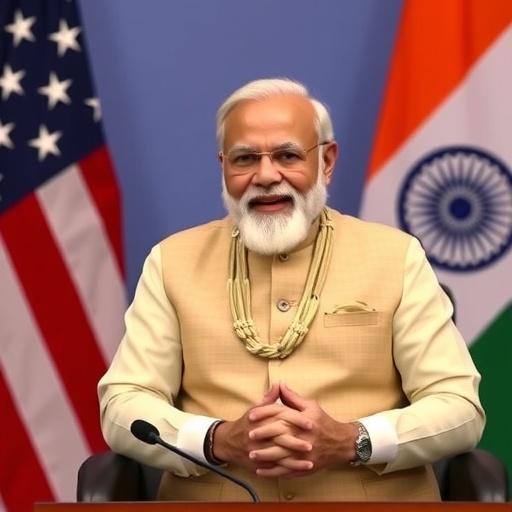Modi Skips In-Person ASEAN Summit as US-India Relations Hit Turbulent Waters
In a move that’s sending shockwaves through diplomatic circles, Indian Prime Minister Narendra Modi has chosen to join the upcoming ASEAN-India Summit virtually, sidestepping what could have been an awkward in-person rendezvous with U.S. President Donald Trump. This decision, announced late Wednesday, underscores deepening cracks in US-India relations, fueled by escalating trade tensions that threaten one of the world’s most promising bilateral partnerships.
- Behind the Screen: Modi’s Calculated Virtual Summit Strategy
- Tariffs and Tech Wars: Unpacking the Trade Tensions Gripping US-India Ties
- ASEAN’s Balancing Act: How Modi’s Absence Reshapes Regional Dynamics
- Voices from the Vanguard: Experts Decode the Diplomatic Jolt
- Charting the Course Ahead: Pathways to Reinvigorate US-India and ASEAN Bonds
The virtual summit format, while not entirely unprecedented in the post-pandemic era, carries heavy symbolic weight. Sources close to the Indian Ministry of External Affairs indicate that Modi’s absence from the physical gathering in Jakarta, Indonesia, is a deliberate strategy to avoid direct confrontation amid ongoing disputes over tariffs, technology transfers, and intellectual property rights. As global supply chains reel from recent economic pressures, this development highlights how personal diplomacy—or its evasion—can amplify broader geopolitical strains.
India and the U.S. share a trade volume exceeding $190 billion annually, according to the latest U.S. Trade Representative data, but recent frictions have cast a shadow over this growth. From Trump’s aggressive ‘America First’ tariffs on Indian steel and aluminum to New Delhi’s retaliatory duties on American motorcycles and whiskey, the two nations are locked in a tit-for-tat battle that’s costing businesses on both sides dearly. Modi’s virtual attendance at the ASEAN Summit thus emerges not just as a logistical choice, but as a barometer of strained US-India relations.
Behind the Screen: Modi’s Calculated Virtual Summit Strategy
Prime Minister Narendra Modi‘s pivot to a virtual summit for the ASEAN-India dialogue isn’t merely about convenience—it’s a masterstroke in navigating thorny international waters. Scheduled for early next month, the summit was poised to be a high-profile affair, drawing leaders from the 10 ASEAN member states to discuss everything from regional security to economic recovery post-COVID. Modi’s in-person presence would have been a coup for India’s ‘Act East’ policy, which seeks to bolster ties with Southeast Asia as a counterweight to China’s regional dominance.
Yet, insiders reveal that the decision stems from a desire to circumvent potential volatility in interactions with Trump, whose administration has repeatedly called out India for its trade practices. ‘The Prime Minister’s schedule is packed with domestic priorities, but this virtual mode allows for focused engagement without the distractions of travel,’ an Indian government spokesperson told reporters, emphasizing Modi’s recent whirlwind tour of domestic infrastructure projects. However, diplomatic analysts see a deeper layer: avoiding a face-to-face that might escalate rhetoric on issues like India’s data localization laws, which irk U.S. tech giants such as Google and Facebook.
Historically, Modi and Trump have shared a rapport—remember their 2019 ‘Howdy, Modi!’ rally in Texas?—but recent barbs have soured that. Trump’s public jabs at India’s high tariffs during a G20 sideline meeting last year, coupled with threats of revoking India’s GSP (Generalized System of Preferences) status, have left New Delhi wary. By opting for virtual participation, Modi signals India’s independence in foreign policy, prioritizing ASEAN partnerships that don’t come with the same baggage as US-India relations.
This isn’t the first time Modi has leveraged virtual formats strategically. During the 2020 pandemic lockdowns, he hosted the QUAD summit online, fostering U.S.-India-Japan-Australia ties without physical meetups. But in the context of the ASEAN Summit, the choice amplifies perceptions of caution. ASEAN leaders, including Indonesian President Joko Widodo, have expressed mild disappointment but understanding, noting in a joint statement that ‘digital diplomacy ensures inclusivity in these challenging times.’
Tariffs and Tech Wars: Unpacking the Trade Tensions Gripping US-India Ties
At the heart of Modi’s virtual sidestep lies a web of trade tensions that have been simmering for years but boiled over in the past quarter. The U.S. imposed 25% tariffs on $1.3 billion worth of Indian steel imports in 2018, prompting India to hit back with duties on $1.4 billion of American goods, including almonds, apples, and iconic brands like Harley-Davidson motorcycles. Fast-forward to today, and these measures persist, with the U.S. International Trade Commission reporting a 15% dip in bilateral goods trade growth last fiscal year.
Technology disputes add fuel to the fire. India’s push for self-reliance under the ‘Make in India’ initiative includes stringent data storage rules, requiring companies to keep user data within the country. This has drawn fire from U.S. firms, with the U.S. Chamber of Commerce estimating potential losses of $25 billion for American tech exports if policies tighten further. ‘These barriers are not just economic; they’re a threat to innovation and our shared democratic values,’ said U.S. Trade Secretary Wilbur Ross in a recent op-ed, underscoring how trade tensions are bleeding into ideological territory.
Statistics paint a stark picture: India’s trade deficit with the U.S. stands at $30 billion, but New Delhi argues that American agricultural subsidies—totaling $28 billion annually—unfairly tilt the playing field. In retaliation, India has dragged the U.S. to the World Trade Organization multiple times, winning a key dispute over solar panel imports last year. Yet, progress remains elusive. A senior Indian trade official, speaking anonymously, lamented, ‘We’ve bent over backwards on defense deals—buying $3 billion in U.S. arms last year alone—but tariffs remain a sticking point.’
These frictions aren’t isolated; they’re part of a global reshuffle. With China as a common adversary, the U.S. and India co-chair the QUAD, yet economic decoupling from Beijing has inadvertently strained their own partnership. Reports from the Brookings Institution suggest that unresolved trade tensions could shave 0.5% off India’s GDP growth by 2025, a sobering prospect for Modi’s economic agenda.
ASEAN’s Balancing Act: How Modi’s Absence Reshapes Regional Dynamics
The ASEAN Summit has long been a cornerstone of India’s Southeast Asian outreach, with trade between India and ASEAN nations surpassing $100 billion in 2023, per ASEAN Secretariat figures. Modi’s virtual attendance, while ensuring his voice is heard on key agendas like the Indo-Pacific strategy, subtly shifts the summit’s tone. Physical absences can dilute the personal chemistry that often seals deals—think of the 2018 ASEAN-India Commemorative Summit where Modi’s charm offensive led to a free trade agreement upgrade.
Indonesia, as the 2024 ASEAN chair, is navigating its own tightrope. President Widodo has voiced ambitions to position ASEAN as a neutral bloc amid U.S.-China rivalry, and an in-person Modi could have amplified India’s role as a bridge. Instead, the virtual format might embolden China, which has ramped up its charm offensive with $50 billion in pledged investments across ASEAN. ‘India’s virtual presence is a missed opportunity for on-ground collaborations in areas like digital economy and climate resilience,’ noted Dr. Lina Gong, a Southeast Asia expert at the Lowy Institute, in an interview.
Yet, there’s a silver lining for New Delhi. The virtual summit allows Modi to multitask, addressing pressing domestic issues like farmer protests and monsoon preparedness. It also frees up bandwidth for bilateral calls with ASEAN counterparts, potentially yielding one-on-one virtual deals. For instance, India recently inked a $10 billion infrastructure pact with Vietnam, a QUAD ally, highlighting how digital diplomacy can pivot to tangible wins.
Broader implications ripple through the region. Singapore’s Prime Minister Lee Hsien Loong, a key player, has urged de-escalation in U.S.-India spats, warning that ‘trade wars hurt everyone in our interconnected supply chains.’ With ASEAN’s GDP projected to hit $3.6 trillion by 2025, any strain in US-India relations could disrupt investment flows, particularly in semiconductors and renewables where India eyes a bigger slice.
Voices from the Vanguard: Experts Decode the Diplomatic Jolt
Reactions to Modi’s virtual summit choice are pouring in from all quarters, offering a mosaic of insights into the evolving US-India relations. Tanvi Madan, director of the India Project at the Brookings Institution, described the move as ‘pragmatic avoidance,’ telling Reuters, ‘Modi isn’t shying away from ASEAN; he’s shielding the partnership from U.S. crossfire. But it risks signaling hesitation at a time when India needs bold leadership in the Indo-Pacific.’
On the U.S. side, former Ambassador to India Kenneth Juster cautioned against overreading the snub. ‘Personal chemistry matters, but policy trumps optics. The real test will be at the next 2+2 dialogue,’ he said, referring to the upcoming U.S.-India ministerial meeting on defense and foreign affairs. Juster, who facilitated $20 billion in defense sales during his tenure, emphasized that while trade tensions persist, shared threats like terrorism and climate change provide glue.
Indian voices echo resilience. External Affairs Minister S. Jaishankar, in a parliamentary address, affirmed, ‘Our engagement with ASEAN remains rock-solid, virtual or otherwise. As for the U.S., dialogue is the path forward.’ Economists like Arvind Subramanian, former Chief Economic Adviser, warn of escalation risks: ‘If tariffs climb another 10%, we could see a 20% drop in IT exports to the U.S., hitting 4 million jobs.’
Global pundits add nuance. The Financial Times opined that Modi’s strategy ‘mirrors Biden-era caution,’ though Trump’s unpredictability looms large. A panel at the Asia Society noted that 68% of surveyed diplomats believe virtual formats will become the norm, potentially easing but also anonymizing tensions.
Charting the Course Ahead: Pathways to Reinvigorate US-India and ASEAN Bonds
As the dust settles on Modi’s virtual pivot, the road forward for US-India relations and India’s ASEAN ties demands strategic recalibration. Negotiators from both Washington and New Delhi are slated for mini-trade talks in the coming weeks, aiming to resolve at least the steel tariff impasse. Success here could unlock India’s inclusion in a U.S.-led economic framework, boosting exports by an estimated $15 billion annually, per World Bank projections.
For the ASEAN Summit, virtual doesn’t mean vacant. Modi plans to unveil a $5 billion digital connectivity fund for ASEAN partners, focusing on 5G infrastructure and e-governance—areas where India can leapfrog without U.S. entanglements. This initiative, detailed in a recent MEA white paper, could foster 1 million jobs across the region by 2030, underscoring India’s commitment despite the format shift.
Looking further, experts predict a hybrid future for diplomacy. With climate summits and G20 meetings increasingly blended, Modi’s choice may normalize such approaches, reducing the carbon footprint of global travel while maintaining momentum. Yet, mending trade tensions requires concessions: India might ease pharma patent rules in exchange for U.S. leniency on H-1B visas, benefiting 80,000 Indian professionals yearly.
Ultimately, the stakes are high. A thawed U.S.-India partnership could counterbalance China’s Belt and Road with a democratic alternative, stabilizing the Indo-Pacific. As Modi prepares his virtual remarks, the world watches: will this be a temporary detour or a sign of deeper rifts? The next moves—from tariff rollbacks to summit follow-ups—will define the trajectory, promising either renewed vigor or prolonged strain in these vital alliances.








